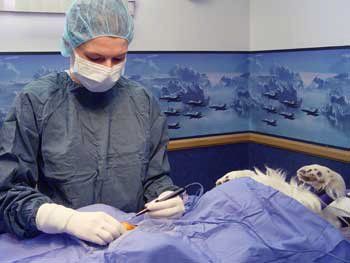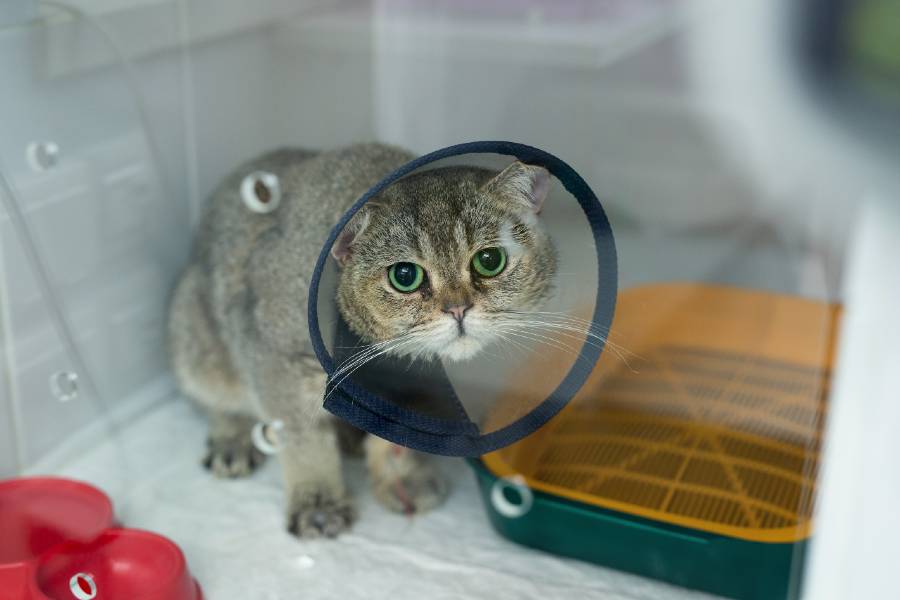Surgery
(jump to spay/neuter)
Our clients are often shocked to learn that we offer same-day or next-day surgery. Skip the waitlist!
We pride ourselves in providing excellent surgical care for your pets. We perform the following types of surgeries:
- Ovariohysterectomy
- Castration
- Cystotomy
- Gastrotomy
- Enterotomy
- Exploratory laparotomy
- Mass removal
- Entropion
- Gingival graft
- Cherry eye
- Stenotic stenosis
- Elongated soft palate
- Mastectomy
- Cesarean section
- Gastropexy (emergency or as a prophylactic surgery to avoid bloat)
- Femoral head osteotomy
- Perineal urethrostomy
- Ear crop
- Tail docking
- Dew-claw ( first digit ) removal
- Dental extraction procedures
- Dental prophylactic procedures
- Aural hematoma surgery
Whenever a member of your family needs surgery—human or animal—it is a scary time. We get that at Normandy Animal Hospital and want to be sure you have all the information you need to feel comfortable when your loved ones need additional care. Here is what you can expect when you bring a pet in for any surgery, including spaying, neutering, and dental procedures.
- Comprehensive exam to be performed by veterinarian prior to the surgery
- A treatment plan (with estimate) and anesthesia consent form to be signed by the owner.
- All surgery patients must be fasted (no food or treats) after 10:00 PM the night before their procedure (limited amounts of water is okay!)
- A staff member will schedule a drop-off time for surgery check-in; usually between 7AM - 9AM. This ensures an appropriate amount of time for the doctor to evaluate the patient before the surgery begins. *$50 penalty will be applied if surgery appointment is not canceled or rescheduled at least 48 hours before the scheduled date for the procedure
- Treatment plan estimate to be paid in full upon drop off of the patient.
- Shaved areas are to be expected where intravenous catheter is placed and where the procedure will take place
- After-surgery pick-up is usually anytime after 3:00 PM the day of, but may be the following day depending on the procedure
- Recheck and post operative exam is needed between 1 to 2 weeks after the procedure date, depending on the procedure
- A device such as an Elizabethian collar has to be used for 1 to 2 weeks after the procedure. Different options may be arranged with the team
- Lab procedures are highly recommended. Preoperative lab work is highly recommended including a heartworm test (if not current)
- Other lab procedures that may be recommended prior or after the procedure or final aspirates, is to pathology, and cytology, and radiographs
Come and see us for your pet surgery in Jacksonville.
What happens when my pet is in surgery?
Surgical Preparation
We clip the hair from the skin surrounding the surgical site and antiseptically scrub it. The surgical personnel will scrub, cap, mask, gown, and glove prior to entering the surgical suite. All of the surgical equipment is sterilized before the operation begins.
Fluids
Almost all of our surgical patients have an IV (intravenous) catheter placed prior to surgery. This allows us immediate access for any medications and fluids required to support your pet throughout surgery. Patients that receive intravenous fluids during the procedure have a small area on one of the front legs clipped to allow sterile placement of the intravenous catheter. The site may still be bandaged at your pet’s release time. You may remove the bandage later in the day.
Warming Methods
While under anesthesia, it is very common for pets to lose body heat and develop a lowered body temperature, which can slow recovery times and result in complications. This is why we place all surgical and dental patients on heated blankets or Bair Hugger® air warmers to maintain healthy body temperature throughout the anesthetic period.
Anesthesia
Local or general anesthesia may be used. Some risk is involved depending upon the general condition of your pet, but precautions are taken to minimize this risk. Anesthesia protocols are tailored to your pet’s individual needs. If a surgical procedure needs to be delayed for any reason, we will contact you immediately to discuss the situation. Isoflorane gas and Sevoflorane anesthesia are used. These are the safest anesthetic agents available for your pet.
Monitor
Heart rate, continuous ECG (electrocardiogram) tracing, respiratory rate, blood pressure, pulse, Carbon dioxide (CO2) and oxygenation saturation are all constantly monitored throughout the procedure by a certified veterinary technician. That technician will monitor your pet before, during, and after surgery.
Surgical Incision
Electrocautery is used to make incisions, remove large masses, or cut away infected/dead tissues. The cut may be closed with sutures (stitches), surgical glue, or staples.
Pain Relief
All surgical veterinary patients receive appropriate pain control pre- and post-surgery to minimize discomfort and optimize healing.
Post-Surgical Care
Your pet’s well-being is monitored continuously by our veterinarians and trained staff until he or she is released back into your care. A trained surgical technician will discuss any home care instructions with you during a special discharge appointment.
Do I need to spay or neuter my pet?
Spaying or neutering is a responsible choice that benefits pets, their families, and society as a whole. In this country, each year millions of cats and dogs are euthanized needlessly—a trend we want to change.
What are the benefits for your pet?
Dogs
- If your female dog is spayed before her first heat cycle, her chances of breast cancer are close to 0%.
- Females who are not spayed can go into heat and potentially become pregnant.
- The chance of females suffering from an infected uterus or mammary tumors is reduced.
- Around the age of 5, male dogs may begin to have issues with their prostate glands. Neutering will help to lessen the chance of prostate problems.
Cats
The noise factor of a cat in heat cannot be denied. Yes, it is loud and annoying to surrounding humans, but it is uncomfortable for her as well. Don’t be fooled if all is quiet; a cat’s reproductive system can go into dormant phases.
- Cats can have 2–3 litters of kittens a year.
- Adult females can be in heat as often as every 2 weeks for 6 months.
- When male cats are neutered the risk of marking behavior is drastically reduced.
How much does it cost to spay or neuter my animal?
For any surgical procedure, even common ones like spaying and neutering, there are multiple factors that come into play and can impact pricing. For that reason, all pets must come in for an appointment first to discuss their specific condition, treatment plan, and pricing when we schedule the procedure.




